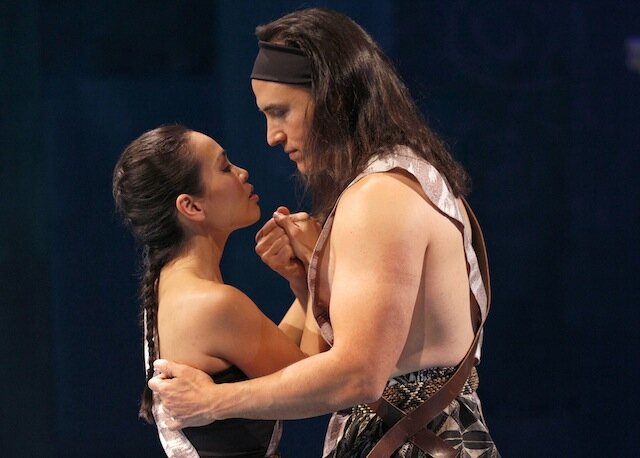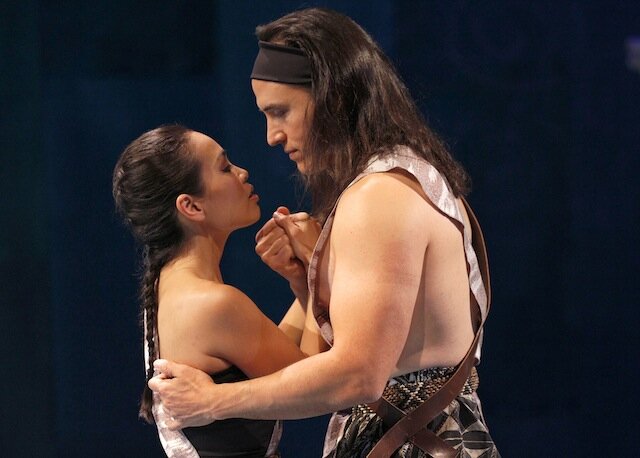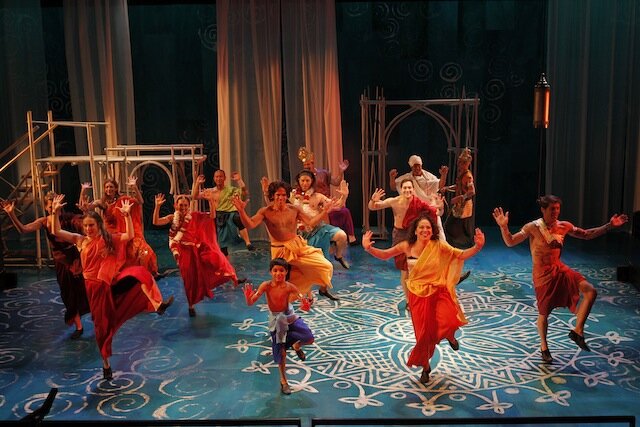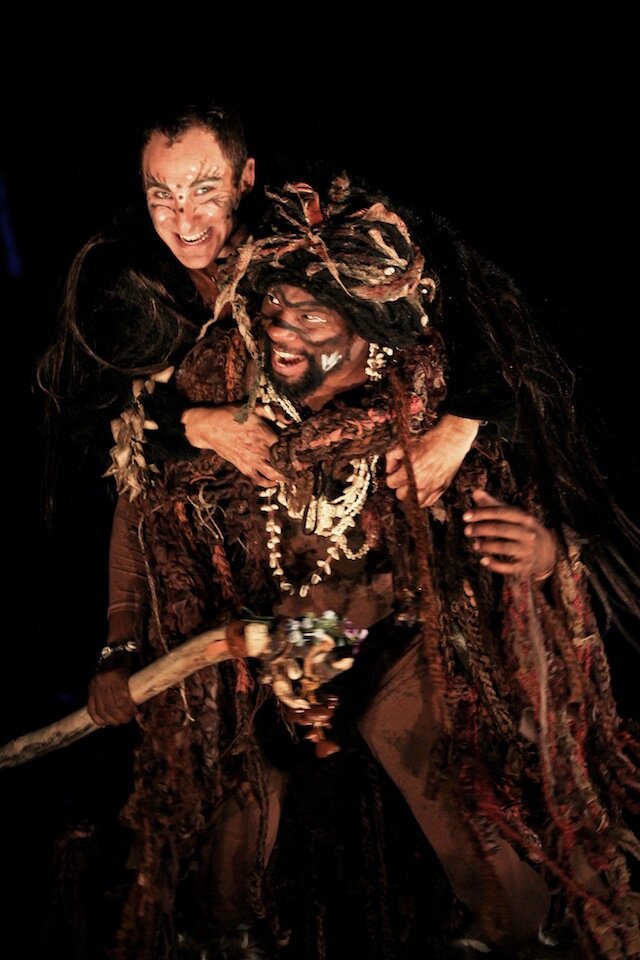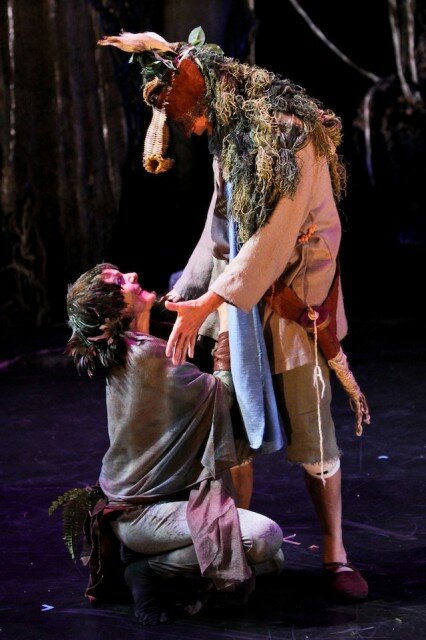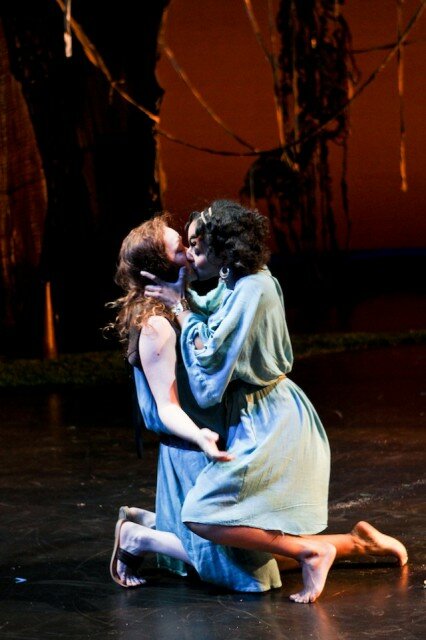The word epic gets tossed around a good deal and not only by theatre theorists interested in Bertolt Brecht but also by young people who find the word “awesome” insufficiently demonstrative. The Ramayana is one of the stories for which the word was fashioned. ACT’s current production (here given the Indian pronunciation: rom-EYE-ah-nah) lives up to the billing with a lightning-fast, three-hour production that leaves us joyful, contemplative, and newly in love with theatre (at ACT through Nov. 11; tickets).
Ramayana is akin to the Iliad in that it is a collection of stories surrounding the abduction of a princess, Sita (Khanh Doan), and the efforts of her husband, Rama (Rafael Untalan), to free her from the demon, Ravana (John Farrage). Within that story are didactic and engaging tales of royal succession, divine intervention, romance, rivalry, jealousy, duty, justice, and more. It touches on nearly every facet of life. With this level of ambition the nearly-three-hour running time feels minimal but the abridgements are handled deftly. Often a few, generally wry, words suggest what is undoubtedly a lengthy litany in the original text.
If there is a flaw in this production it is that actors are sometimes lost from view on the floor. The problem is the mark of a very fully enacted and absorbing production. Physical actions reach up atop a second story and often collapse in prostration but unless the prone actor is at least as far upstage as center we lose sight of him in the silhouettes of those in front of us—this coming from someone who is well over six feet tall.
In a lesser production this would be a minor quibble (who worries about missing a bit of action?) but there is nothing extraneous in Ramayana, every prop and gesture incites our interest. When Ray Tagavilla as Rama’s brother, Bharata, bows before him, he also removes Rama’s shoes and places them on a throne as a symbol of the servitude of his regency. Missing that bit of action can create a hole in a narrative that—rich as it is—can be nearly as spare as CliffsNotes given the eventful plot.
The genius of this production finds its emblem in the portrayal of Jatayu, the eagle, who attempts to rescue Sita as Ravana abducts her. Jatayu enters as the shadow of a simple rod puppet (designed by Greg Carter). The puppet is cardboard-thin and elaborately painted and perforated as in wayang kulit, the traditional Indonesian shadow puppetry form in which the Ramayana is often performed.
After crossing the scene this depiction graduates from a direct reference to a new evocation. Jatayu returns in the form of a woman with a gauze shawl, shadowed by gauze draped over three poles that suggest a bird’s body with wings. This gives us a simple and modern depiction of the enormous physical bird and its very human emotional conditions. Similarly the adaptation as a whole both references the traditions of the Ramayana and updates the visual and fabulistic elements to serve ACT’s audience with both the colloquial and the spiritual, low and high arts. All told it is a transcendent achievement.
Despite the story’s vast scale physically, philosophically, and emotionally, the production easily sells us on emotions that could seem laughable to American audiences. Tagavilla is brilliantly cast in his most prominent role as Bharata, who unwillingly winds up serving as regent during Rama’s exile. He makes the immensity of Bharata’s torment at his impossible position both palpable and natural.
Farrage has a similar achievement. Though, as Ravana, he sustains an aggravated voice for most of the show he largely avoids seeming cartoonishly villainous. Anne Allgood’s entrance as Ravana’s sister, Soorpanaka, has all that cartoonish villainy, yet laughing at her tragic obsessiveness frees the audience to feel a childlike delight. That we gasp in horror at her subsequent treatment returns our equilibrium and keeps the show grounded.
Soorpanaka’s disfigurement is not the only time the audience audibly gasps at the simple magic onstage. Sita and Rama disappear, a giant destroys battalions before Rama’s arrows lay him down, characters are consumed in fire, and all of it furloughs our disbelief. Matthew Smucker’s sets and Brendan Patrick Hogan’s sound design elevate simplicity into enchantment by engaging our imagination. The set mostly consists of bamboo and gauze. The sound design often both cues from and reinforces live instruments and voices, expanding the scale of the tangible.
But rather than laud the contributions to this production with an epic of criticism, let it suffice to say that from the adept adaptation to Hanuman’s hijinks, ACT’s Ramayana is a tremendous success and worth repeated attendance.
